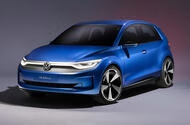Volkswagen is gearing up for a significant transformation in its electric vehicle lineup, and the upcoming ID 2 supermini is set to lead the charge. This new model, slated for launch in 2026, marks a pivotal moment for the brand as it transitions to a more cost-effective and efficient battery technology. Let’s dive into what this means for Volkswagen and the electric vehicle (EV) landscape.
What’s New with Volkswagen’s Electric Vehicles?
Starting next year, Volkswagen plans to shift all its electric cars to an updated platform known as MEB Plus. This change is not just a minor tweak; it’s a complete overhaul that will introduce lithium-iron-phosphate (LFP) batteries across the lineup. These batteries are expected to be cheaper than the nickel-manganese-cobalt (NMC) packs currently used in their EVs, making electric cars more accessible to a broader audience.
The ID 2 will be the first model to utilize this new battery technology, which has gained traction in the industry due to its cost advantages and improved range. LFP batteries have been around for a while, but recent advancements have made them a viable option for mass-market vehicles. Tesla was among the first to adopt this technology with the Model 3 in China, and now Volkswagen is following suit, joining the ranks of other major manufacturers like Ford with its Mustang Mach-E.
Why LFP Batteries Matter
So, why is Volkswagen making this switch to LFP batteries? The answer lies in cost and performance. According to Volkswagen CEO Thomas Schäfer, the transition to MEB Plus and the introduction of cell-to-pack battery systems with LFP will significantly reduce costs while enhancing performance. This is crucial for Volkswagen as it aims to compete effectively in the growing EV market.
LFP batteries are particularly appealing for mass-market vehicles because they offer a lower price point without compromising too much on range. While NMC batteries have been the go-to for high-performance applications, LFP is emerging as the go-to technology for volume production. This strategic shift could help Volkswagen not only lower production costs but also pass those savings on to consumers, making electric vehicles more affordable.
What’s Next for Volkswagen’s ID Lineup?
The rollout of LFP batteries will extend beyond the ID 2. Models like the ID 3, ID 4, and ID 7 are also set to benefit from this battery technology. Volkswagen plans to produce these batteries at its new factory in Salzgitter, Germany, which will also continue to manufacture NMC packs on a smaller scale until they are phased out.
In addition to the technological upgrades, Volkswagen is also focusing on a design refresh for its ID lineup. R&D boss Kai Grunitz emphasized that this redesign aims to bring “huge improvements” and reconnect the brand with its roots. Schäfer echoed this sentiment, highlighting the importance of iconic design in attracting consumers. He believes that regardless of whether a vehicle is electric or petrol, an appealing design can create a strong emotional connection with potential buyers.
What This Means for Consumers
For consumers, these changes signal a promising future for electric vehicles. With the introduction of more affordable and efficient battery options, the dream of owning an electric car is becoming increasingly attainable. As Volkswagen rolls out its new models, buyers can expect not only better pricing but also enhanced performance and range.
The big takeaway? Volkswagen’s shift towards LFP batteries isn’t just about cutting costs; it’s about making electric vehicles more appealing and accessible. As the company embraces this new technology, it’s paving the way for a more sustainable and consumer-friendly future in the automotive industry. If you’re considering making the switch to electric, keep an eye on Volkswagen’s upcoming releases—you might just find the perfect fit for your needs.

